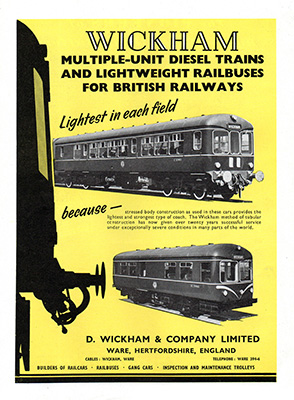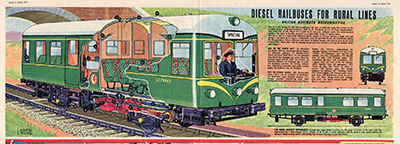Wickham Railbus
Description
Underframe
The underframe was the same length as the body and had leaf spring buffers fitted. It was formed from two rectangular frames, braced together by vertical members to form a deep truss. Each frame was a welded 2 3/8 x 10g. square tube structure of four longitudinal members with cross members of similar section.
Baker Bessemer wheels 33 inch in diameter were hydraulically pressed onto the axles in the usual manner. The Wickham cast steel axleboxes were fitted with a double row SKF roller bearing and carried underslung Woodhead semi-elliptic springs, clamped to the axleboxes at their centre. No hornguides were used, the axleboxes were attached to the frame by steel radius arms, with rubber connecting bushes of the Metalastik type. These rubber pads were held in brackets suspended from the frame. These brackets were formed from two channels welded back to back on the inside and outside of the underframe. This construction eliminated wear, lubrication points and noise, reduced weight and contributed to better riding.
A Woodhead Monroe hydraulic shock absorber was vertically mounted above each axlebox to damp spring oscillation.
Two 6 in x 5 1/2 in brake cylinders for each axle were mounted on the inner frame longitudinals, operating through fully compensated clasp rigging. The handbrake at each end of the car operated on the adjacent axle through the power brake rigging.
Duplex spring steel buffers were mounted on each end of the chassis, at the same height above the rails as the buffers on standard stock. A light type of towing eye and towing coupling were fitted so that in emergency a railbus could be towed behind a standard vehicle. The emergency towing coupling was normally carried inside the vehicles with the other emergency kit.
Body
A solid drawn steel square tube frame of 1 1/2 in x 10g. Section was used for the main members of the welded structure. The top-hat floor section floor supports were welded to the channel cross-members of 4 1/2 in x 2 in x 10g section. On the floor supports was laid 1/8 in aluminium alloy sheeting and flame-proofed hardboard 1/2 in thick. Both the inner and outer roof skins were of 16g aluminium riveted to a formed spacer. Sprayed asbestos insulation was applied between the inner and outer body panels and around the heater ducting.

The D. Wickham and Company advert featuring a DMU and railbus mentions the stressed body tubular construction that made them the lightest in each field.
The body was flexibly counted on six Cushyfoot mountings which incorporated rubber buffers to limit transverse movement. To get around the problem of the exhaust pipe connection to the vertical tailpipe in the flexible mounted body, the lower end of the tailpipe was formed as a venturi into which projected the exhaust pipe from the underframe. This meant there was no mechanical connection, and the cold air drawn in by the venturi suction prevented any leakage of fumes. Cooling of the gas was also believed to improved the silencing.
The two side doors were fabricated from 10g. Aluminium sheet with Argon arc welded-on stiffeners where necessary. Large fixed plate glass windows were mounted in rubber mouldings. The doors were air operated and controlled from the driver's cabs, with two pushbuttons operating each door and warning lights glowing when the doors were opened. Their control was electro-pneumatic; the control switches were supplied by CAV Ltd. And the door operating cylinders were made by Wickham.
Power Train
The engine was a newly introduced six-cylinder horizontal Meadows diesel engine, type 6HDT500. It was rated for road transport at 130hp but in this case it was derated to 105hp at a governed speed of 1,800rpm.
Mounted directly on the engine flywheel was a Freeborn-Wickham disc and ring coupling. This automatic coupling was a multiple clutch device which acted like a fluid coupling when the engine was idling but locked into firm engagement when normal running speed was reached. Automatic engagement of the clutch was by a series of spring controlled pivoted centrifugal weights. The outer driving plates driven from the flywheel were of the normal plate-clutch type, with teeth on the outer rim. The inner driven plates were a series of circular discs, pin-mounted on the driven member in the manner of a ring of planet gears.
Each disc, with the outer portion sandwiched between two driving plates, was free to rotate on its bearing pivot. This rotation of the discs, which occurred only during the period of engagement, had the dual function of giving a smooth take-up of the drive and a cooling of the friction surfaces. The relative velocity of the engaging surfaces was low and the discs stopped rotating when the clutch was fully engaged. The pressure plate was loaded by the centrifugal weights thrusting outwards against wedge members. When the engine speed dropped to idling, compression springs returned the pressure plate to the clutch-free position. A small quantity of oil, 1/5 pint, was contained in the clutch for lubrication.
The coupling was connected to a four speed air-operated SCG Wilson R11C gearbox. Top gear was through a multi-plate clutch, the indirect ratios through the epicyclic trains were 4.07, 2.42 and 1.6:1.
From the gearbox, via a Hardy Spicer cardan shaft with needle roller bearing universal joints at each end, the drive was taken to a type 'D' Wickham double bevel reverse 3.45:1 reduction box mounted on the drive axle; this box was one of a wide range made by Wickham. The spiral bevel drive, as on the more common AEC types had an air operated sliding dog for changing direction. Torque reaction was taken through a rubber-bushed link anchored to the underframe.
The power unit rating was lower than the other railbuses; on test runs it showed a fuel consumption of approximately 9 mpg.
Inside of the non-driving axle was located a 70 gallon fuel tank, arranged for filling from each side. The Smiths heater was mounted transversely on the frame and fuel for the heater was drawn from the main fuel supply.
For auxiliary drives, a cardan shaft was taken from the front end of the engine crankshaft to a Wickham auxiliary bevel box, radiator fan, alternator and compressor being neatly grouped around this fitting.
The radiator, fan and cowling were of Leyland manufacture. The water was circulated through the engine and cooling system by a belt driven centrifugal pump mounted at the free end. The system as not pressurised, and in the delivery pipe between the engine and radiator was fitted a centrifugal steam trap which diverted any steam direct to the header tank via a small bore pipe. In trials this cooling system appeared more than adequate. The 8 gallon water header tank and the radiator were on opposite sides of the underframe.
Two of the vehicles had experimental features. 79968 was fitted with a CAV automatic gear change, a dashboard device which enabled the driver to select either manual or automatic control of his gears. 79969 was fitted with Andre Westinghouse pneumatic suspension in place of the standard semi-elliptic axlebox springs.
Dimensions
| Weight, tare | 11 1/2 tons |
| Weight, fully loaded | 15 tons (18 with 100% overload) |
| Length, overall | 39' 10" |
| Length, over body | 38' 0" |
| Width | 9' 0" |
| Height | 12' 7 1/2" |
| Wheelbase | 19' 0" |
| Wheel dia | 2' 9" |
| Max Speed | 54mph |
| Acceleration 0-10 | 7 secs |
| " to 20 | 19 secs |
| " to 30 | 36 secs |
| " to 40 | 67 secs |
| " to 50 | 117 secs |
| Braking distance from 50mph | 200 yds down 1 in 67 |

A cutaway drawing of a vehicle appeared in the March 14th 1959 issue of Eagle comic.
Summary
Description
Interiors
Suspension
Numbering
Operations
Elliot Track Recorder
Images
Details about the preserved Elliot Wickham railbus can be found here.


